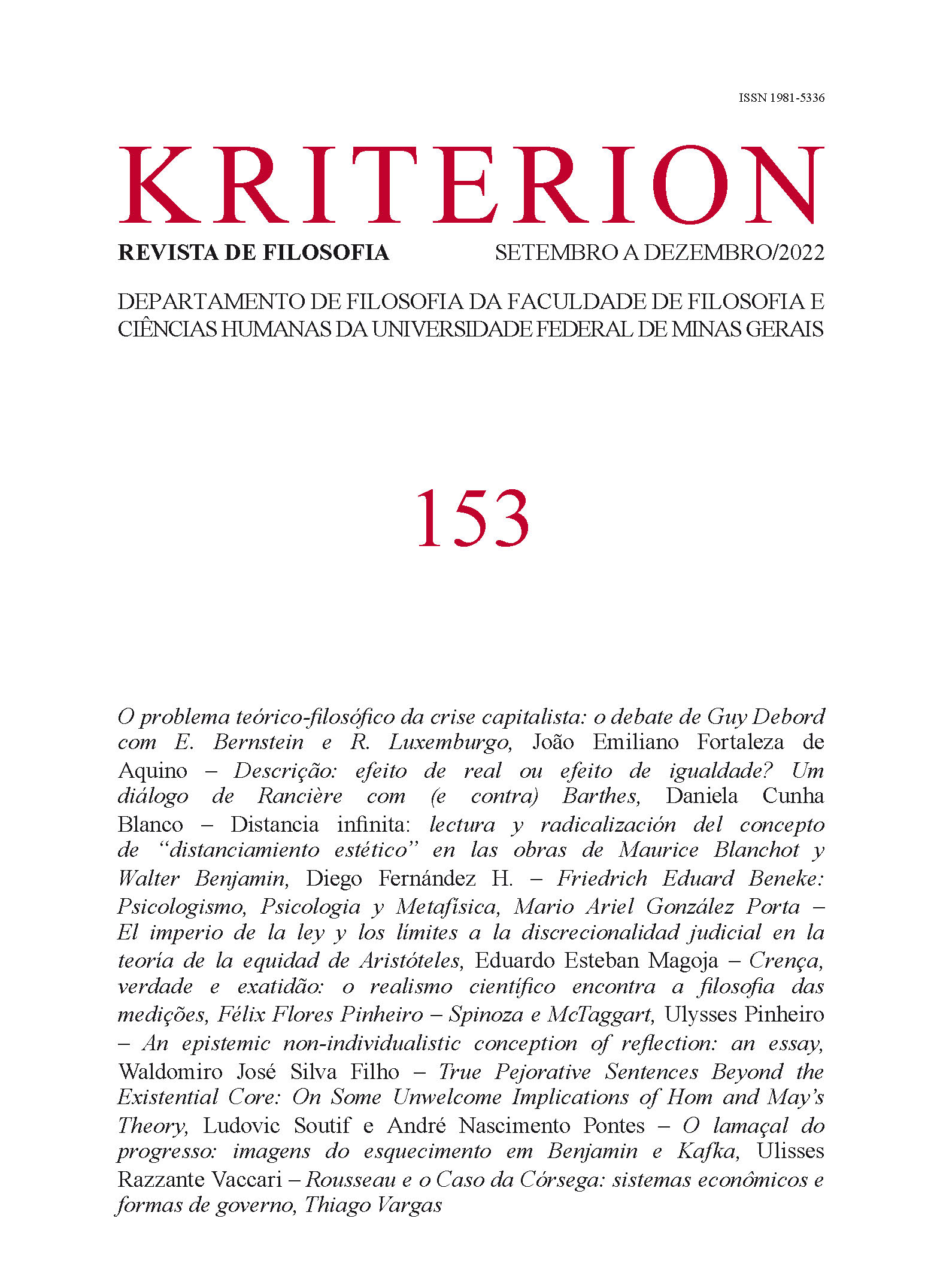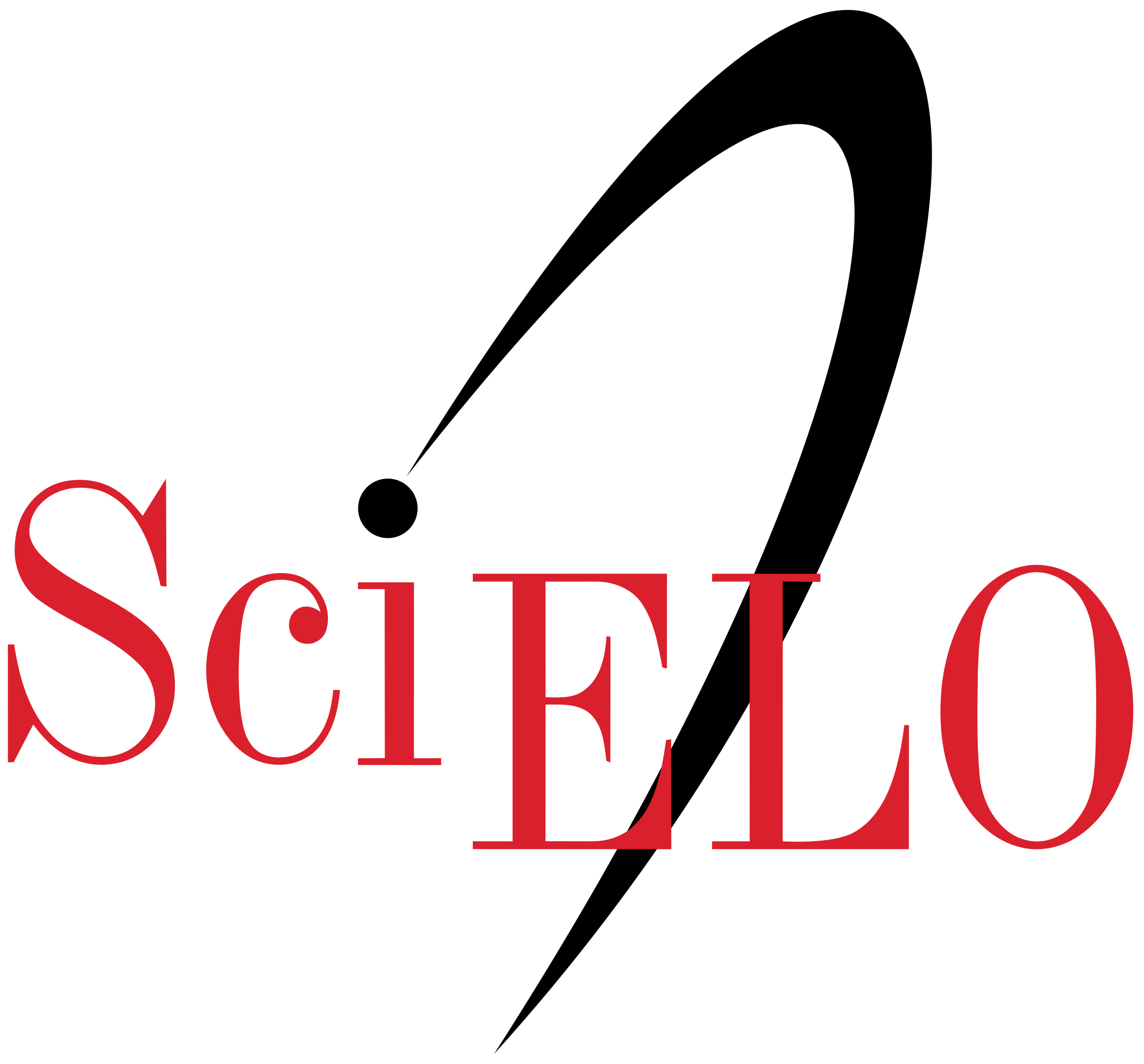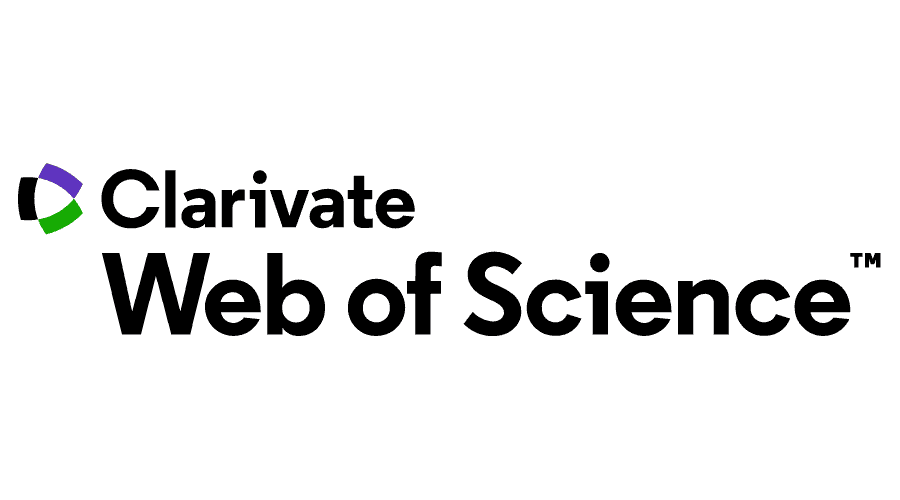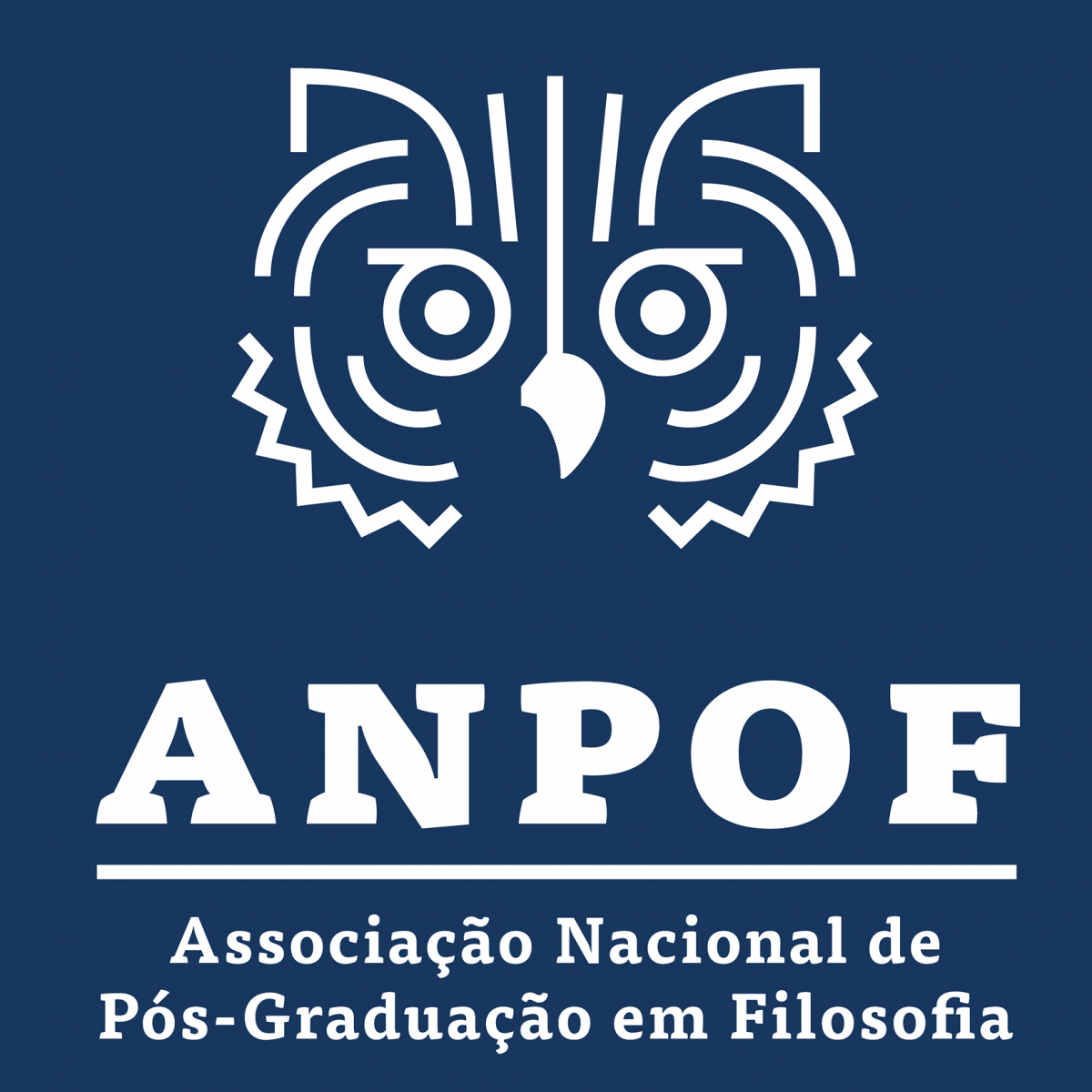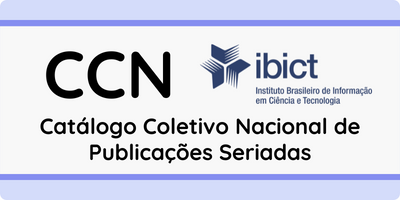DISTANCIA INFINITA
LECTURA Y RADICALIZACIÓN DEL CONCEPTO DE “DISTANCIAMIENTO ESTÉTICO” EN LAS OBRAS DE MAURICE BLANCHOT Y WALTER BENJAMIN
Palavras-chave:
aesthetic distance, infinite distance, art criticism, limit-experience, désœuvrementResumo
Aunque el concepto de “distancia infinita” (DI) aparece como tal sólo en la obra de Maurice Blanchot, sostenemos que es legítimo imputárselo a Walter Benjamin para dar cuenta de un mismo problema. En el presente artículo, sostenemos (1) que el concepto de DI se elabora sobre la base de una revisión, una re-significación y una radicalización del concepto moderno de “distanciamiento estético”, y que (2) esta modificación se realiza fundamentalmente a partir de las interpretaciones que tanto Benjamin como Blanchot hacen primero del temprano romanticismo alemán, y más tarde de la obra de Franz Kafka. Esa modificación, sostenemos, por último, (3) contiene un desplazamiento en el fundamento del concepto: el concepto de DI ya no tiene por base el ámbito de las facultades subjetivas (i.e. el ‘juicio de gusto’), sino el ámbito del arte y del lenguaje. Mostramos así (4) que el concepto de DI supone la existencia de un ‘impulso fragmentario’ al interior de las obras literarias, que se manifiesta como “experiencia-límite” para la subjetividad.
Referências
BENJAMIN, W. (1981). Sobre Kafka. Trad. M. Dimópulos. Buenos Aires: Eterna Cadencia, 2014.
_____ (1919). “El concepto de crítica de arte en el romanticismo alemán”. In: ¬BENJAMIN, W. Obras. Tomo 1. Vol. 1. BARJA, J., DUQUE, F., y GUERRERO, F. Trad. J. Navarro y A. Brotons. Madrid: Abada. 2006.
_____ (1917). “Sobre El programa de filosofía venidera” In: ¬BENJAMIN, W. Obras. Tomo 1. Vol. 1. BARJA, J., DUQUE, F., y GUERRERO, F. Trad. J. Navarro y A. Brotons. Madrid: Abada. 2007a.
_____ (1912-1913). “Diálogo sobre la religiosidad del presente”. In: ¬BENJAMIN, W. Obras. Tomo 2. Vol 1. BARJA, J., DUQUE, F., y GUERRERO, F. Trad. J. Navarro y A. Brotons. Madrid: Abada. 2007b.
_____ (1913). “Experiencia”. In: ¬BENJAMIN, W. Obras. Tomo 2. Vol. 1. BARJA, J., DUQUE, F., y GUERRERO, F. Trad. J. Navarro y A. Brotons. Madrid: Abada. 2007c.
_____ (1925 [1928]). El origen del drama barroco alemán. Trad. J. Muñoz, Madrid: Taurus, 1990.
_____ (1916). “Sobre el lenguaje en general y el lenguaje del hombre”. In: BENJAMIN, W. Obras, Tomo 2. Vol 1. BARJA, J., DUQUE, F., y GUERRERO, F. Trad. J. Navarro y A. Brotons. Madrid: Abada. 2007d.
____ (1939). “Sobre algunos temas en Baudelaire”. In: BENJAMIN, W. Obras. Tomo 1. Vol 2. BARJA, J., DUQUE, F., y GUERRERO, F. Trad. J. Navarro y A. Brotons. Madrid: Abada. 2008a.
____ (1936). “La obra de arte en la era de su reproductibilidad técnica”. In: BENJAMIN, W. Obras, Tomo 1. Vol 2. BARJA, J., DUQUE, F., y GUERRERO, F. Trad. J. Navarro y A. Brotons. Madrid: Abada. 2008b.
_____ (1923). “‘Las afinidades electivas’ de Goethe”. In: Dos ensayos sobre Goethe. Trad. G. Calderón y G. Mársico. Barcelona: Gedisa, 2000.
_____ (1927-1940 [1983]). El libro de los pasajes. Trad. I. Herrera, L. Fernández, F. Guerrero. Madrid: Akal, 2005.
_____ (1940 [1980]). “Sobre el concepto de historia”. In: La dialéctica en suspenso. Fragmentos sobre la historia. Trad. P. Oyarzun, Santiago de Chile: Lom, 1995.
BLANCHOT, M. L’Espace littéraire, Paris: Gallimard, 1955.
_____ (1949). “Kafka y la literatura”. In: De Kafka a Kafka. Trad. J. Ferreiro. México, D.F.: Fondo de Cultura Económica, 1991a.
_____ (1955). “Kafka y la exigencia de obra”. Trad. J. Ferreiro. México, D.F.: Fondo de Cultura Económica, 1991b.
_____ (1981). De Kafka à Kafka, París: Gallimard.
_____ L’Entretien infini, Paris: Gallimard, 1969.
_____ “La voz narrativa” (el ‘él’, el neutro)”. In: (1969). La conversación infinita. Trad. I Herrera. Madrid: Arena, 2008.
_____ “El Athenaeum”. In: (1969). La conversación infinita. Trad. I Herrera. Madrid: Arena, 2008.
Comentarios
ALFARO, C.V. “El vínculo entre la figura del espíritu denominada ‘alma bella’ y el ‘mal infinito’ o ‘mala infinitud’ en la filosofía de Hegel”. Eidos, Nr. 30, 2019.
BERKMAN, G. “‘Une histoire dans le romantisme?’ Maurice Blanchot et l’Athenaeum”. In: MCKEANE, J. y OPELZ, H. (Eds.). Blanchot Romantique. A collection of essays (Vol. 17). Oxford y Nueva York: Peter Lang, 2011.
BROD, M (1938). Kafka. Trad. C. Grieben. Madrid: Alianza, 1974.
BOZAL, V. “Orígenes de la estética moderna”. In: BOZAL, V. (Ed.). Historia de las ideas estéticas y de las teorías artísticas contemporáneas, Vol. 1. Madrid: Visor, 2000.
CAYGILL, H. Walter Benjamin: The Colour of the Experience. New York: Routledge, 2008.
DEUBER-MANKOWSKY, D. Der frühe Walter Benjamin und Hermann Cohen. Jüdische Werte, Kritische Philosophie, vergängliche Erfahrung. Berlin: Verlag Vorwerk 8, 199.
DICKIE, G. The Century of Taste: The Philosophical Odyssey of Taste in the Eighteenth Century. Oxford: Oxford University Press, 1996.
FENVES, P. The Messianic Reduction. Walter Benjamin and the Shape of Time, Stanford: Stanford University Press, 2011.
FERNÁNDEZ-CASTAÑEDA, L. Experiencia y lenguaje en Walter Benjamin. Tesis presentada en la Facultad de Filosofía de la U. Autónoma de Madrid, 1999.
FERRIS, D. “Truth is the Death of Intention: Benjamin’s Esoteric History of Romanticism”. Studies in Romanticism. Vol. 31, Nr. 4, 1992.
FORT, J. The Imperative to Write. Destitutions of the Sublime in Kafka, Blanchot, and Beckett. Nueva York: Fordham University Press, 2014.
FRANK, M. (1994). The Philosophical Foundations of Early German Romanticism. Trad. E Millán- Zaibert. Nueva York: State University of New York, 2004.
HABERMAS, J. (1985). El discurso filosófico de la modernidad. Trad. M. Jiménez. Madrid: Taurus, 1989.
HANSON, S. “This Double Exigency: Naming the Possible, Responding to the Impossible”. In:
BLANCHOT, M. The Infinite Conversation. Minnesota: The University of Minnesota Press, 2003.
HAMACHER, W. (1998). “No-llamado”. In:Lingua Amissa. Trad. L. Carugati y M. Burello, Buenos Aires: Miño & Dávila, 2012.
HARTUNG, G. (2000). “Mito”. Trad. M. Castel. In: OPITZ, M. Y WIZISLA, E. (Eds.). Conceptos de Walter Benjamin. Buenos Aires: Las cuarenta, 2014.
HEGEL, G.W.F. (1842). Lecciones sobre estética. Trad. A. Brotons. Madrid: Akal, 2007.
_____ (1807). Fenomenología del espíritu. Trad. W. Roces. México, D.F.: Fondo de Cultura Económica, 1985.
HUME, D. (1757¬). “Of the Standard of Taste”. In: Essays: Moral, Political, and Literary, Forgotten Books, 2015.
HUGHES, J. “Renewing the Infinite Conversation: System and Method in Blanchot”. Philosophy Today. Vol. 56, Nr. 4, 2012.
KAFKA, F. (1926). El Castillo. Trad. M. Sáenz. Madrid: Alianza, 2013.
LORENT, F. “Genèse et réception de L’Absolu littéraire. Les échappées d’une commande”. COnTEXTES. Revue de sociologie de la littérature. Vol. 29, 2020.
KANT, I. (1790). Crítica de la facultad de juzgar. Trad. P. Oyarzun, Caracas: Monte Ávila, 1992.
KOSELLECK, R. (1974). historia / Historia. Trad. A. Gómez. Madrid: Trotta, 2004.
LACOUE-LABARTJE, Ph., y NANCY, J.-L. L’absolu littéraire. Théorie de la littérature du romantisme allemand, Paris: Seuil, 1978.
_____ (1978). El absoluto literario. Teoría de la literatura del romanticismo alemán. Trad. C. González y L. Carugati. Buenos Aires: Eterna Cadencia, 2012.
LAVELLE, P. Religion et histoire: sur le concept d’expérience chez Walter Benjamin. París: Cerf, 2008.
MENNINGHAUS, W. (1986). Saber de los umbrales. Walter Benjamin y el pasaje del mito. Trad., M. Vargas y M. Simeesen. Buenos Aires: Biblos, 2013.
ONETTO, B. y PORTALES, G. Poética de la infinitud. Santiago de Chile: Intemperie/Palinodia, 2005.
PRADA, J. M. “David Hume y el juicio estético” Revista de Filosofía. Vol. 73, 2017.
RANCIÈRE, J. Malaise dans l’esthétique. París: Galilée, 2004.
_____. Le spectateur émancipé. París: La Fabrique, 2008.
SCHILLER, F. (1795). Escritos sobre estética. Trad. M. G. Morente, M. J. Callejo, J. González. Madrid: Tecnos, 2000.
SCHULTE-SAßE, J. “Distanz / Distanzlosigkeit, ästhetische”. In: RITTER, J., GRÜNDER, K., GABRIEL, G. (Eds.). Historisches Wörterbuch der Philosophie. Basilea: Schwabe, 1971-2003.
WADHAM, J., “Blanchot, Benjamin, and the Absence of the Work”. In: MCKEANE, J. y OPELZ, H. (Eds.). Blanchot Romantique. A collection of essays. Oxford y Nueva York: Peter Lang, 2011.
WOHLFARTH, I. “Walter Benjamin: le ‘medium’ de l’histoire” Etudes Germaniques. Vol. 51, Nr.1, 1996.
Downloads
Publicado
Edição
Seção
Licença
Copyright (c) 2022 Revista Kriterion

Este trabalho está licenciado sob uma licença Creative Commons Attribution 4.0 International License.

